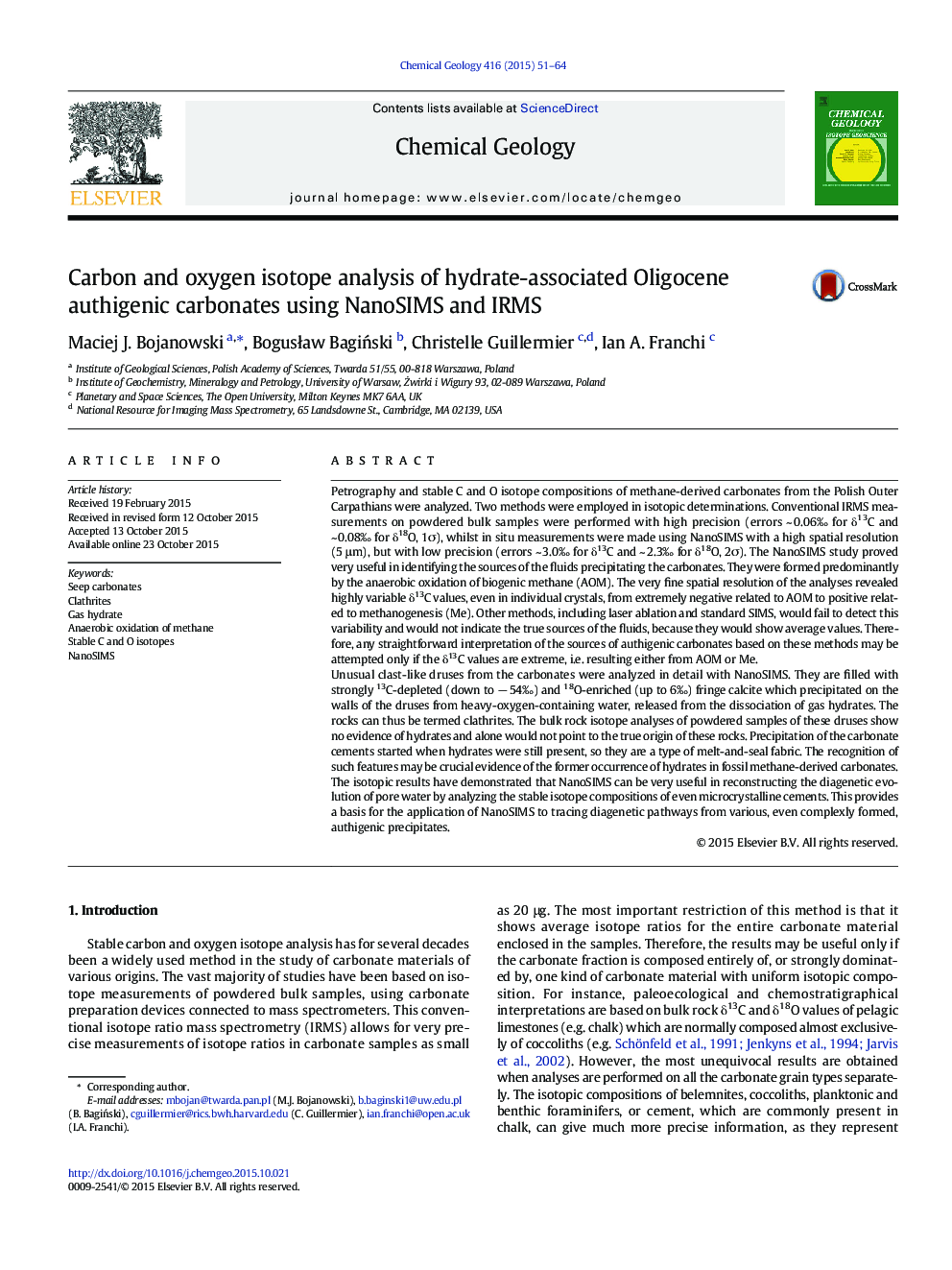| کد مقاله | کد نشریه | سال انتشار | مقاله انگلیسی | نسخه تمام متن |
|---|---|---|---|---|
| 4698441 | 1637558 | 2015 | 14 صفحه PDF | دانلود رایگان |

• We analyzed stable C and O isotopic composition of seep carbonates using conventional IRMS and NanoSIMS.
• NanoSIMS analyses were performed in 5 μm large spots with errors ~ 3.0‰ for δ13C and ~ 2.3‰ for δ18O, 2σ.
• NanoSIMS analyses revealed strong variability of δ13C related to anaerobic oxidation of biogenic methane and methanogenesis.
• IRMS analyses gave average δ13C values and, as well as many other methods, would not show the true sources of carbon.
• Isotopic C and O composition and melt-and-seal fabric indicate that the rocks were formed by decomposition of gas hydrates.
Petrography and stable C and O isotope compositions of methane-derived carbonates from the Polish Outer Carpathians were analyzed. Two methods were employed in isotopic determinations. Conventional IRMS measurements on powdered bulk samples were performed with high precision (errors ~ 0.06‰ for δ13C and ~ 0.08‰ for δ18O, 1σ), whilst in situ measurements were made using NanoSIMS with a high spatial resolution (5 μm), but with low precision (errors ~ 3.0‰ for δ13C and ~ 2.3‰ for δ18O, 2σ). The NanoSIMS study proved very useful in identifying the sources of the fluids precipitating the carbonates. They were formed predominantly by the anaerobic oxidation of biogenic methane (AOM). The very fine spatial resolution of the analyses revealed highly variable δ13C values, even in individual crystals, from extremely negative related to AOM to positive related to methanogenesis (Me). Other methods, including laser ablation and standard SIMS, would fail to detect this variability and would not indicate the true sources of the fluids, because they would show average values. Therefore, any straightforward interpretation of the sources of authigenic carbonates based on these methods may be attempted only if the δ13C values are extreme, i.e. resulting either from AOM or Me.Unusual clast-like druses from the carbonates were analyzed in detail with NanoSIMS. They are filled with strongly 13C-depleted (down to − 54‰) and 18O-enriched (up to 6‰) fringe calcite which precipitated on the walls of the druses from heavy-oxygen-containing water, released from the dissociation of gas hydrates. The rocks can thus be termed clathrites. The bulk rock isotope analyses of powdered samples of these druses show no evidence of hydrates and alone would not point to the true origin of these rocks. Precipitation of the carbonate cements started when hydrates were still present, so they are a type of melt-and-seal fabric. The recognition of such features may be crucial evidence of the former occurrence of hydrates in fossil methane-derived carbonates.The isotopic results have demonstrated that NanoSIMS can be very useful in reconstructing the diagenetic evolution of pore water by analyzing the stable isotope compositions of even microcrystalline cements. This provides a basis for the application of NanoSIMS to tracing diagenetic pathways from various, even complexly formed, authigenic precipitates.
Journal: Chemical Geology - Volume 416, 27 November 2015, Pages 51–64